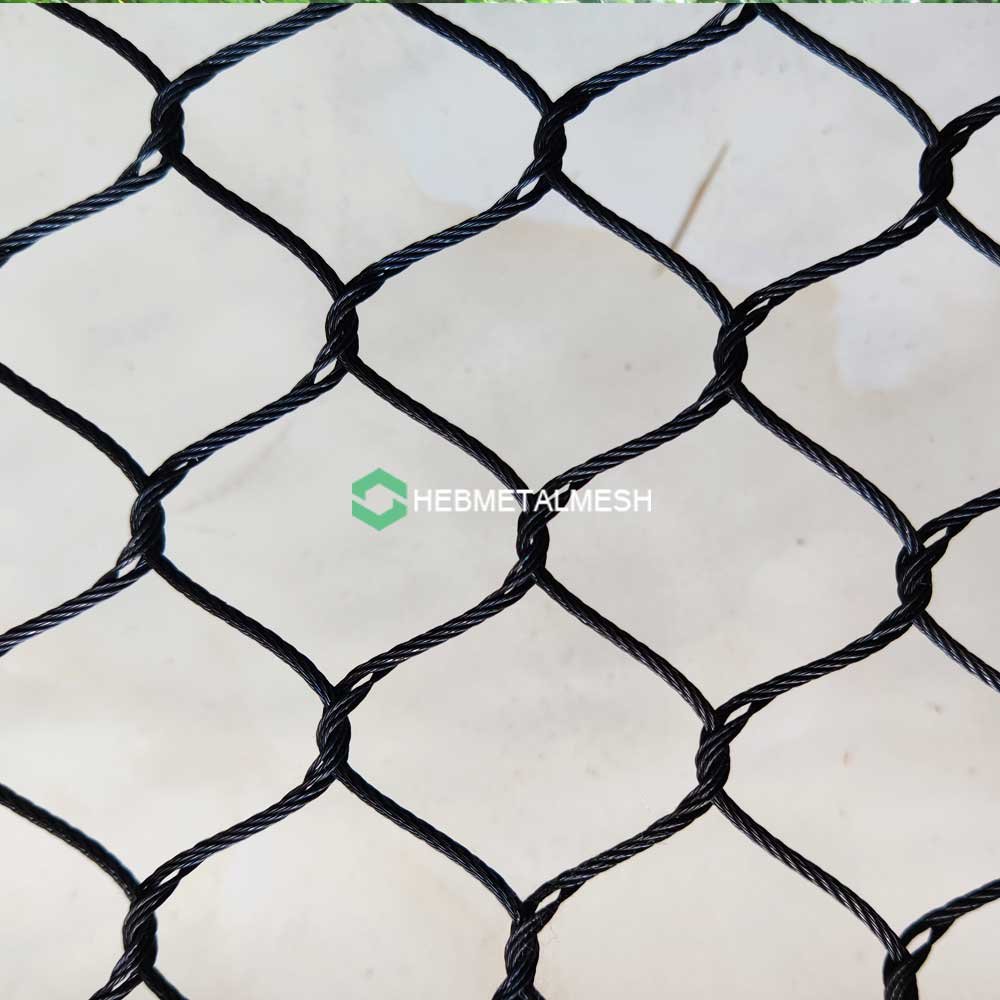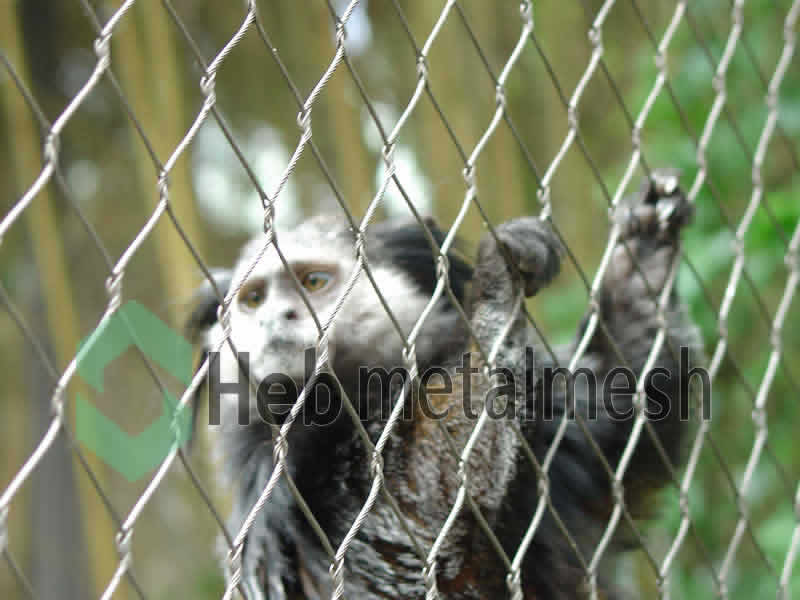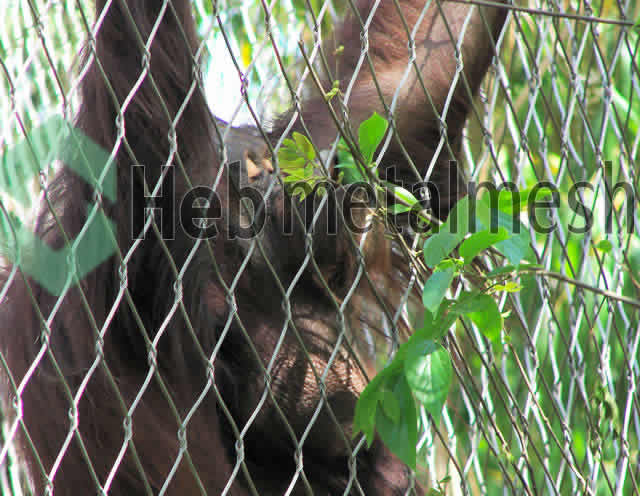Introduction to Rope Nets
Rope nets are versatile structures crafted from interwoven strands of robust materials, primarily utilized for a variety of applications ranging from sports equipment to recreational structures and, significantly, in enclosures for zoos and aviaries. The design of these nets is characterized by a network of interconnected ropes, forming a grid-like pattern that allows for flexibility while maintaining strength. This unique combination of properties makes rope nets particularly well-suited for environments where safety, durability, and adaptability are paramount.
Commonly manufactured from high-quality materials, stainless steel has emerged as a leading choice due to its impressive resistance to environmental factors such as corrosion and rust. This characteristic is essential, especially in outdoor settings where exposure to weather conditions could compromise the integrity of the netting. Beyond stainless steel, other materials such as nylon and polyester are also used, depending on the specific requirements of the application. These fibers can endure significant loads, making them ideal for creating secure enclosures that ensure the safety of animals while providing ample space for movement.
The flexibility of rope nets allows for creative and diverse design possibilities, enabling designers to cater to various aesthetic and functional needs. This adaptability is particularly beneficial in zoo and aviary settings, where enclosures must not only serve a practical purpose but also enhance the visual appeal of the habitats. Whether used to create climbing structures, barriers, or containment systems, the rope net serves as an excellent solution, ensuring a safe, functional, and visually engaging environment for both animals and visitors. Thus, the reliable performance of rope mesh across multifaceted applications underscores their importance in modern design and architecture.
The Importance of Quality in Rope Net Production
The manufacturing process of rope nets is a critical element in ensuring their effectiveness and safety for various applications, particularly in zoo and aviary enclosures. Quality in rope net production is paramount, as it directly influences the durability, functionality, and overall performance of the nets. As the primary safety barrier for animals and a means of providing enriched environments, these nets must meet rigorous industry standards.
A high-quality rope net is composed of materials that resist abrasion, UV degradation, and environmental impact. For instance, the use of specialized synthetic fibers like nylon or polyethylene can enhance longevity and performance under varying conditions. Proper material selection not only contributes to the lifespan of the rope mesh but also helps to minimize maintenance costs for facilities that rely on these structures. When quality materials are bypassed, the risk of seam failure or net deterioration can increase, posing hazards to both the animals within and the visitors nearby.
Hebmetalmesh exemplifies a manufacturer that understands the importance of quality. They employ stringent quality control measures during both the production and testing phases of their rope nets. Each net is subjected to comprehensive inspections to ensure they meet predefined standards, focusing on tensile strength, knot integrity, and overall design robustness. Furthermore, Hebmetalmesh invests in advanced production technologies to enhance the quality of their rope mesh, ensuring that they meet or exceed industry certifications.
By concentrating on quality in rope net production, manufacturers like Hebmetalmesh not only enhance the user experience of zoos and aviaries but also promote animal welfare and safety. Ultimately, high-quality rope nets serve as essential components in creating secure and enriching environments for wildlife. Investing in quality is not merely a choice; it is an obligation for those committed to sustainable and responsible animal management.
Hebmetalmesh: A Leader in Stainless Steel Rope Net Manufacturing
Hebmetalmesh has established itself as a premier manufacturer of stainless steel rope nets, renowned for its innovation and quality in the production of specialized netting solutions. Founded over a decade ago, the company has accumulated extensive experience in the industry, focusing on the development of sturdy yet flexible netting products suitable for various applications, such as zoo and aviary enclosures. With a core mission to provide solutions that ensure safety and functionality, Hebmetalmesh has become a trusted name in the market.
The expertise of Hebmetalmesh lies in understanding the unique requirements of clients across different sectors. Their skilled team is adept at customizing designs to meet specific needs, whether for large-scale wildlife parks or smaller aviaries. The production facilities are equipped with advanced technology, which enhances the manufacturing processes and allows for high-volume outputs without compromising quality. Each rope net undergoes rigorous testing to ensure that it meets international safety standards, providing peace of mind to clients who prioritize the well-being of both animals and visitors.
Hebmetalmesh prides itself on its commitment to sustainable practices, utilizing eco-friendly materials and processes wherever possible. This dedication to environmental stewardship resonates with a growing number of clients who seek not only quality but also ethical sourcing in their purchasing decisions. In addition to their manufacturing capabilities, the company offers comprehensive support throughout the project lifecycle, assisting clients from design to installation. The combination of quality materials, innovative designs, and excellent customer service positions Hebmetalmesh as a leader in the stainless steel rope net sector, recognized for setting industry benchmarks.
Flexible Handwoven Stainless Steel Rope Netting: Features and Benefits
Hebmetalmesh specializes in a versatile range of flexible handwoven stainless steel rope netting, which boasts multiple features that make it ideal for various applications, particularly in zoo and aviary enclosures. One of the primary attributes of this type of rope net is its strength. Constructed from high-grade stainless steel, these nets demonstrate substantial tensile strength and durability, capable of withstanding extreme environmental conditions while ensuring the safety of the animals housed within.
Aesthetically, flexible rope nets offer a unique visual appeal, aligning seamlessly with the natural surroundings of enclosures. Their fine design allows for transparency that provides an unobtrusive barrier, enabling visitors to observe the animals closely without the distortion often created by traditional fencing materials. This aspect promotes an enhanced viewing experience and enriches the overall atmosphere of the habitat.
Furthermore, the versatility in design is a significant advantage of Hebmetalmesh’s handwoven rope nets. These nets can easily be customized to fit various shapes, sizes, and configurations, making them suitable for a wide array of settings. Whether creating an aviary that mimics a natural habitat or a secure space for larger animals, the flexibility of the rope mesh allows it to adapt to specific requirements. The installation process is also straightforward, contributing to reduced labor and time costs for zoo operators and wildlife facilities.
Another notable benefit is the low maintenance required for these stainless steel rope nets. The corrosion-resistant properties of stainless steel ensure longevity, significantly minimizing the need for frequent replacements or repairs. This financial efficiency continues to make rope mesh an appealing choice for animal enclosures. Overall, Hebmetalmesh’s contributions through handwoven stainless steel rope nets affirm its commitment to enhancing the structural integrity and aesthetic appeal of wildlife habitats.
Applications of Rope Nets in Zoo Enclosures
Rope nets have emerged as a quintessential material in the design and construction of zoo enclosures, offering a multitude of benefits for both animals and visitors. One of the primary advantages of utilizing rope nets for animal containment is their ability to create secure environments while maintaining a high level of visibility. Unlike traditional fencing, rope nets facilitate an unobstructed view of the animals, thus enhancing the overall visitor experience. Enthralling displays of wildlife become more accessible as visitors enjoy a clearer perspective of the animals in their habitats.
Furthermore, rope nets are particularly effective in providing a flexible and adaptable containment solution, accommodating the natural behaviors of various species. For instance, Hebmetalmesh has been instrumental in deploying rope nets across numerous zoo enclosures, showcasing their commitment to animal welfare. In one notable case, a renowned zoo integrated rope mesh into its monkey habitat, allowing the primates to climb and swing freely. This design not only enriched the animals’ lives by promoting natural behaviors but also ensured a secure containment solution.
From a safety perspective, rope nets significantly reduce the chances of injury to both animals and humans. Their soft structure mitigates potential harm during confrontations or accidental falls, particularly for agile species that thrive in climbing scenarios. The unique design of rope nets is also beneficial in safeguarding against escapes; the inherent flexibility and resilience of the material deter animals from attempting to breach the enclosure. As more zoo facilities recognize these advantages, the integration of rope mesh continues to gain traction as a preferred choice for creating secure, humane, and visually appealing animal habitats.
Bird Aviary Netting: Enhancing Safety and Aesthetics
Bird aviaries serve as safe havens for various species of birds while offering an environment that mimics their natural habitats. The integration of rope nets in the design of these enclosures has proven essential not only for safety but also for enhancing the overall aesthetic appeal of the birds’ surroundings. A well-implemented rope mesh allows for unobstructed visibility, enabling both birds and visitors to engage with the space effectively. Moreover, the netting fosters good airflow, which is crucial for the health and wellbeing of the birds.
When considering bird aviary netting, several factors must be taken into account. The dimensions and materials of the rope nets play a prominent role in ensuring the safety of the birds. For instance, the choice of mesh size is vital; it must be small enough to prevent escape or predation yet large enough to maintain visibility and airflow. Furthermore, the durability of the materials used is crucial, as they must withstand environmental elements as well as potential wear and tear from the birds themselves. Hebmetalmesh specializes in manufacturing custom-designed rope nets that are tailored explicitly for aviary needs, ensuring that these considerations are met without compromising on design.
The aesthetic aspect of rope nets also contributes to the overall experience within an aviary. By employing natural colors and textured materials, these nets blend seamlessly with the environment, thus minimizing visual obstruction. Overall, Hebmetalmesh’s innovative approach to bird aviary netting effectively combines safety and aesthetics, creating an engaging and secure environment for both the birds and their human visitors. This versatility positions rope nets as a cornerstone element in the evolution of modern aviary design.
Installation and Maintenance of Rope Nets
When it comes to the installation of rope nets, careful planning and attention to detail are essential. First, it is vital to select the appropriate type of rope mesh based on the specific requirements of the enclosure. Factors such as the species of animals, enclosure size, and anticipated levels of wear and tear should guide this selection process. Using high-quality materials can enhance the durability and safety of the installation.
The installation process begins with assessing the structural integrity of the supporting framework. Ensure that the supports are robust enough to bear the weight and tension that the rope net will exert. It is advisable to follow the manufacturer’s guidelines, as they often provide insights on anchoring techniques and load capacities. Employing tensioning devices can help secure the net firmly in place, minimizing sagging and potential hazards. Additionally, using appropriate knots and fasteners will increase the overall safety and functionality of the net.
Once installed, ongoing maintenance is crucial to prolong the lifespan of the rope net. Regular inspections should be conducted to check for wear, fraying, or damage. Areas that experience more friction or tugging may require closer scrutiny, and any signs of deterioration should be addressed immediately. Cleaning the rope net periodically can help preserve its appearance and functionality; using mild detergents and soft brushes will prevent the accumulation of debris while avoiding potential damage from harsh chemicals.
Furthermore, maintaining the net’s tension is essential, as loose or sagging areas can pose risks to both animals and visitors. Re-tensioning the net periodically will help maintain its structural integrity. By following these installation and maintenance best practices, enclosures featuring rope nets can remain safe, secure, and visually appealing for years to come.
Customer Testimonials and Success Stories
Hebmetalmesh’s rope nets have garnered substantial positive feedback from clients across various sectors, particularly in the field of zoo and aviary enclosures. Many customers have reported enhanced safety and security for animals as a result of implementing these robust, versatile nets. One client, who oversees a large urban zoo, stated, “The rope nets from Hebmetalmesh have transformed our animal enclosures. They are not only durable but also allow for greater visibility, enabling better interaction between visitors and the animals.” This sentiment is echoed by numerous other clients who have praised the combination of strength and transparency offered by rope nets in their facilities.
Another customer, managing an exotic bird sanctuary, highlighted the functional aesthetic of Hebmetalmesh’s rope nets. “Our birds are not just safe; they enjoy their space more with the breathable and flexible nature of the nets,” they remarked. This versatility facilitates natural behaviors in wildlife while ensuring protection from escapes and external threats. The rope net’s design promotes a more enriching environment, which has contributed to an increase in visitor engagement and satisfaction.
Furthermore, a wildlife rehabilitation center shared a successful project where they utilized Hebmetalmesh’s rope nets in a massive aviary restoration. “We were impressed with how easy the installation process was, allowing us to reopen quicker than expected. The quality of these nets is unmistakable, and our birds have thrived in their new habitat,” they stated. Customer feedback consistently highlights the quality, durability, and aesthetic qualities of rope nets, reinforcing Hebmetalmesh’s reputation for delivering high-quality products tailored to the specific needs of wildlife facilities.
Conclusion: The Future of Rope Nets in Zoos and Aviaries
As we reflect on the evolving role of rope nets in zoo and aviary design, it is evident that these versatile structures have not only enhanced the safety and well-being of animals but also contributed significantly to the aesthetic and functional aspects of enclosures. The adaptation of rope nets allows for a more naturalistic setting, which is crucial for the mental and physical health of both captive animals and aviary occupants. Innovations in materials and construction techniques have further broadened the applications of rope nets, ensuring durability and sustainability in such environments.
Moreover, the integration of rope nets into zoo and aviary projects promotes interactive and engaging experiences for visitors. By employing these nets, designers are able to create dynamic spaces that encourage exploration, spontaneity, and a deeper connection to wildlife. The ability of rope nets to blend seamlessly into natural habitats while providing structural support has proven beneficial in both educational and conservation efforts.
Looking ahead, the future of rope nets in zoological and aviary applications looks promising. As more facilities recognize the significant advantages they offer, there is a potential for increased adoption in innovative designs. Beginnings of such trends are already evident, with institutions emphasizing eco-friendly materials and practices. Designers are also exploring the use of rope mesh in conjunction with technology to monitor animal health and behavior effectively.
In summary, the commitment to utilizing rope nets in zoo and aviary enclosures not only aligns with modern design principles but also fosters a greater appreciation for wildlife conservation. For those considering enhancements to their projects, Hebmetalmesh offers a range of high-quality rope nets tailored to meet the specific needs of zoos and aviaries, ensuring both safety and visual appeal.
FAQs
A stainless steel rope net is a durable, corrosion-resistant mesh made from interwoven stainless steel cables. It’s designed for heavy-duty applications like safety barriers, zoo enclosures, playground equipment, and architectural designs (e.g., balcony or stair railings). Popular for its strength and longevity, it’s ideal for those searching for “rust-resistant rope netting for outdoor use” or “high-strength stainless steel safety nets.” Industries like construction, marine, and landscaping also use it for fall protection or securing cargo.
Stainless steel rope nets outperform nylon and galvanized alternatives in harsh environments due to their rust resistance, UV stability, and ability to withstand extreme temperatures. If you’re researching “best rope netting for coastal areas” or “long-lasting industrial safety nets,” stainless steel is the go-to choice. Unlike nylon, it won’t degrade in sunlight, and unlike galvanized steel, it resists corrosion from saltwater or chemicals, making it cost-effective long-term.
Yes! Stainless steel rope nets are widely used in playgrounds, zoos, and aviaries because they’re non-toxic and smooth-edged, preventing injuries. For terms like “child-safe stainless steel playground nets” or “animal enclosure rope netting solutions,” the material’s flexibility and strength ensure safety without compromising security. Proper installation with rounded clamps and regular inspections further minimize risks of snagging or sharp edges.
Installation requires anchoring the net to sturdy frames or structures using corrosion-resistant clamps and tensioning hardware. DIY guides for “how to install stainless steel rope netting for balconies” recommend measuring the area, securing anchor points, and evenly tensioning the net to prevent sagging. For complex projects like “custom architectural rope net installations,” hiring professionals ensures compliance with safety standards and load-bearing requirements.
With minimal upkeep, stainless steel rope nets can last 15–20+ years. Routine maintenance involves rinsing off dirt/debris and checking for loose fittings. Searches like “low-maintenance stainless steel cargo nets” or “marine-grade rope netting durability” highlight its suitability for demanding environments. Avoid abrasive cleaners to preserve the finish, and inspect for rare issues like cable fraying in high-stress areas.


